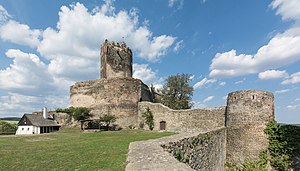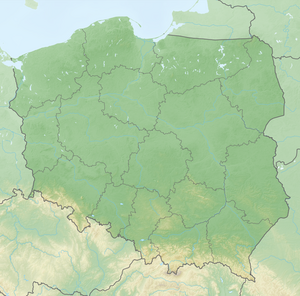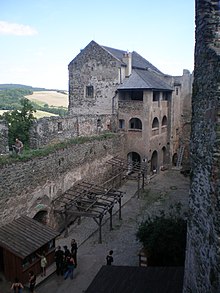Bolkoburg
| Bolkoburg | ||
|---|---|---|
| Alternative name (s): | Zamek Bolków | |
| Creation time : | around 1270 | |
| Castle type : | Höhenburg, spur location | |
| Conservation status: | ruin | |
| Place: | Bolków | |
| Geographical location | 50 ° 55 '17.7 " N , 16 ° 5' 52.1" E | |
|
|
||
The ruins of the Bolkoburg (initially Hain Castle , until around 1820 Bolkenhainer Castle ; Polish Zamek w Bolkowie ; Latin Hain castrum ) are located in Bolków in the Powiat Jaworski in the Lower Silesian Voivodeship in Poland. It is located in the foothills of the Giant Mountains on the right bank of the Angry Neisse on a ridge.
history
The complex, initially referred to as Burg Hain or Hainburg , was first mentioned in 1277 as "Hain castrum". It was probably built around 1270 by Duke Bolesław II of Liegnitz as a border fortress. After the division of the Duchy of Legnica in 1278, the area became part of the Duchy of Jawor , which for Duke Bolko I. had been rebuilt. He expanded the town of Hain and expanded the Hainburg , where he lived until the Fürstenstein Castle was built . Its name is said to have been transferred to the city at the end of the 14th century. From the beginning, the Hainburg took over the central function of the older Kastellaneiburg Schweinhaus .
After the death of Duke Bolko II , the Duchy of Schweidnitz-Jauer fell to Bohemia under inheritance law in 1368, with the Dowager Duchess Agnes von Habsburg being entitled to a lifelong usufruct . She put burgraves on the Hainburg , u. a. until 1371 Hans von Logau , followed by Gottsche Schoff and then Günzel von Schweinhaus . Only after the death of the Dowager Duchess in 1392 could the Bohemian King Wenceslaus , who was a son of Bolkos II's niece Anna von Schweidnitz , inherit the now Bohemian hereditary principality Schweidnitz-Jauer. At the head of his hereditary principality he installed Bohemian governors, who exercised the function of royal governors and who were able to acquire the Bolkenhain castle feud in pledge. The castle loan, which consisted of the town and castle as well as the villages of Einsiedel, Giesmannsdorf, Hohenhelmsdorf, Ruhbank, Klein-Waltersdorf and Wiesau, came to the provincial governor Jan von Chotěmice in 1412 , who had lent money to the king. Before 1439 the castle loan was in the hands of Heinrich von Tschirn, who was probably a robber baron and was able to hold it until 1459. In 1463 the Bohemian King Georg von Podiebrad conquered Bolkenhain, who installed Hans von Tschirn at the castle. In 1468 the castle was taken by Schweidnitzer and Breslau troops.
After the Czech anti-king Matthias Corvinus had succeeded in 1474, its dominion over Silesia stretch, he appointed in 1475 the Hungarian magnate Stephen Zápolya the upper governor of Silesia and Governor of Erbfürstentums Świdnica and Jawor. At the same time he gave him the castle loan with the city of Bolkenhain as a pledge. He was followed in 1484 as pledge holder by Governor Georg von Stein . From 1494 the castle loan belonged to the Tschirnhaus family and from 1532 to the Breslau bishop Jakob von Salza , in whose family it remained until 1570. The following pledge holder was Governor Matthias von Logau until 1591. The castle and town were then converted into an inheritance, which was acquired by Jakob von Zedlitz on Nimmersath in 1598 , with whose descendants it remained until 1700. Because of an inheritance dispute after the death of Gotthard Albrecht von Zedlitz, the castle and town fell in pledge to the main creditor, the Grüssau monastery , from which both were acquired in 1703. Since the castle was no longer adequately maintained and no longer inhabited, it fell into disrepair. Even after the castle and town fell to the Prussian state after the secularization of the Grüssau monastery in 1810, which had come to most of Silesia after the First Silesian War in 1742, the decay of the castle was not stopped.
Around 1820 romantic writers gave the castle, which until then was known as "Bolkenhain Castle", the name "Bolkoburg", which subsequently became established. It was not until the end of the 19th century that security and reconstruction work was carried out on the castle. In 1923 a youth hostel and a local museum were set up in part of the castle. After the transition to Poland in 1945, the local history museum was reopened in 1953.
Description of the castle
The Gothic spur castle consisted of a keep in the southwest and a residential building in the northeast. It was expanded in the 14th century, creating connections between the surrounding wall of the castle and the city walls . Around 1540, the builder Jakob Pahr from northern Italy carried out a renovation in the Renaissance style . After outer castles were built in the north, west and south , the Bolkoburg reached its greatest extent in the 16th century.
In the inner courtyard there is now a lapidarium , in which, in addition to tombstones from the surrounding churches, the castle's architectural decor can be seen. City views of Bolkenhain and castles in Silesia as well as weapons and objects from the history of the castle are shown in the castle museum.
literature
- Hugo Weczerka (Hrsg.): Handbook of the historical places . Volume: Silesia (= Kröner's pocket edition . Volume 316). Kröner, Stuttgart 1977, ISBN 3-520-31601-3 , pp. 32-35.
- Dehio Handbook of Art Monuments in Poland. Silesia. Deutscher Kunstverlag, Munich a. a. 2005, ISBN 3-422-03109-X , pp. 159-161.
- Günther Grundmann : Castles, palaces and manor houses in Silesia - Volume 1: The medieval castle ruins, castles and residential towers . Verlag Wolfgang Weidlich, Frankfurt am Main 1982, ISBN 3-8035-1161-5 , pp. 85-94.
- Karl August Müller: Patriotic images, in a history and description of the old castle festivals and knight castles of Prussia. Glogau 1837, pp. 505-515.
- P. Nikolaus: Bolkenhain Castle at the beginning of the 18th century. In: The hiker in the Giant Mountains. Breslau 1928, pp. 95-97.
- Karl August Müller: Patriotic images, in a history and description of the old castle festivals and knight castles of Prussia. Glogau 1837, pp. 505-515.
Web links
Individual evidence
- ↑ Information here from HB hist. Stätten, p. 32f. According to other sources, the name of the city is said to have been derived from Duke Bolko II, who died in 1368, at the request of his widow. According to Schweinhaus Castle , it was only introduced at the beginning of the 19th century and according to Dehio-Handbuch -Schlesien p. 157 the city was named Bolkenhain after Duke Bolko I from the 14th century and the castle only from the 18th / 19th century . Century.
- ↑ P. Ambrosius Rose: Grüssau Monastery . Stuttgart 1974, ISBN 3-8062-0126-9 , p. 96.




